TSUNAMI - EXIT ONLY SURVIVES THE GLOBAL
TSUNAMI
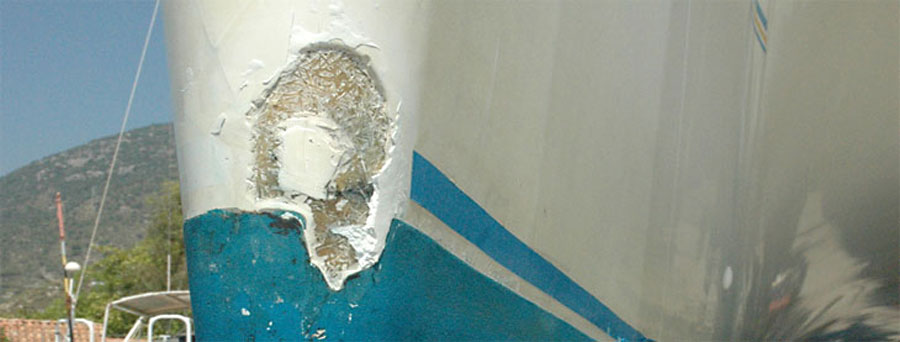
TSUNAMI DAMAGE - THE STARBOARD BOW TAKES
A LICKING AND KEEPS ON TICKING!
In Thailand, Exit Only survived the
most destructive tsunami of modern times without a scratch, but
we didn't escape scot-free. The arm of the tsunami was
very long, and out in the middle of the Indian Ocean, the
tsunami made a lasting impression on Exit Only's starboard bow.
The
starboard bow is the bow of destruction. Two times Exit Only has
collided with things at sea, and it's always the starboard bow that
takes the beating.
When Exit Only left the factory in France, she was sailed to England to
be placed on a ship for delivery to America. Unfortunately, the
delivery captain ran into something and knocked a fist sized hole in the
bow. I don't know what he hit, and believe it or not, he didn't
report the damage. He repaired it with body filler and covered it
over with gel coat. The Privilege dealer in Florida didn't mention
the damage, and I had the boat for a year before I discovered telltale
cracks in the gel coat when I hauled the boat out of the water for a
bottom job. Only then did the dealer tell me about the damage to
the bow.
At that point, I was starting a circumnavigation, and it was imperative
that I discover the extent of the damage, and whether it was properly
repaired. I removed the gel coat with a grinder and
discovered to my chagrin that they had put body filler in the hole
rather than do a proper repair using fiberglass. It was the worst
type of shoddy workmanship and substantially weakened the strength of
the bow. A repeated collision at sea could have been disastrous
with this substandard repair.
In the boat yard I exposed the entire area of damage and performed a
professional repair that restored the bow's integrity. I
beefed up the bow to make it more impact resistant in case I ever hit a
partially submerged container or log while at sea. Then I applied
new gel coat to finish the repair.
Exit
Only was never at risk of sinking when holed because there is a
collision bulkhead twelve inches back from the bow. This bulkhead
prevented any significant amount of water from entering the yacht.
Only a few cups of water were in the space ahead of the collision
bulkhead.
It was a disappointment to have a hole in the bow of a totally new
yacht, and disappointing that the yacht dealer didn't admit to the
damage until I discovered its tell tale signs a year later, but in the
long haul I may be fortunate that we had the damage to the starboard
bow. Why do I say that?
If I
hadn't beefed up the bow to repair the hidden damage, then when I ran
into a log south of Sri Lanka after the tsunami, it might have put a
devastatingly large hole in the bow rather than just create the gel coat
damage shown in this picture.
One of the things that concern every captain
at sea is the possibility of collision with partially submerged
containers and logs. In the Indian Ocean, some of the floating
logs were more than a hundred feet long and a meter thick.
Collision with such a log can sink a ballasted monohull yacht in under
five minutes. In a catamaran a log won't sink you, but it can
cause flooding of one hull.
You never know ahead of time whether apparent disaster is actually good
or bad. I wasn't happy about the damage to the starboard bow that
I discovered in Fort Lauderdale, but that discovery and repair may have
saved me from a humongous problem in the Indian Ocean eleven years
later.
That's they way things are in life. Although you live in the short
term, life is a long term proposition. What looks like disaster in
the short term, may be a blessing in the long haul. There's truth
in the saying, "What doesn't kill me makes me stronger." It was
certainly true for Exit Only's starboard bow.
I'll take gel coat damage any day when I hit a log in the Indian Ocean.
Repairing gel coat at my leisure in a boatyard is a world better than
having to deal with a gaping hole in the bow in the middle of the Indian
Ocean.
If you want to sail the seven seas, you must become an expert at turning
bad things into better things, and when bad things happen, you might
discover that dealing with the bad thing actually protected you from
something even worse.
When bad things happen, it's not time to put on sackcloth and sit in a
pile of ashes. It's time to keep on keeping on.
It's never over until it's over, and in spite the hole in my starboard
bow, life is still good.
Click on
this button to tell your friends about Positive Faith Not Fear.

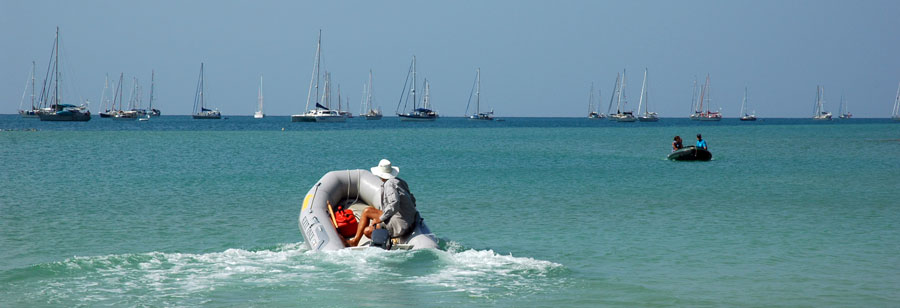
LOCATION, LOCATION, LOCATION. TSUNAMIS
ARE ALL ABOUT LOCATION!
If you are in the wrong location, a tsunami
will kill you. If you are in the right location, a tsunami will
pass by without giving you even a scratch. It's all about
location. When you visit Tsunami Land, it's worth paying attention
to your location. It may save your life.
Where you anchor your yacht will decide to a
significant degree what happens to you during a tsunami. You can
make choices that decrease the risk of damage and injury during a major
tsunami event.
During a tsunami, millions of gallons of
water move in and out of bays in an oscillating manner. The
magnitude and proximity of the inciting earthquake will influence how
much water will be displaced during the tsunami. The shape and
size of the bay,
and the water depth in your anchorage will influence whether the tsunami is a
major personal disaster or simply another adventure that you experience
during your circumnavigation.
It's bad to be anchored in shallow water close to shore in a tsunami.
When the water is drawn out of the bay, your yacht will be sitting on
the seabed waiting for a humongous wave to sweep over it, pick it up and toss
it on the shore, rocks, pilings, wharfs or on top of whatever happens to
get in the way. Anchoring close to shore in shallow water is an
invitation to disaster in a tsunami.
Being anchored in deep water over fifty feet
in depth and far from shore, substantially decreases the risk of serious
damage during a tsunami. You probably won't get hit by a tsunami
wave in deep water. Instead, your greatest risk will be from other
yachts and debris striking your hull as the tsunami water sloshes in and
out of your harbor. The tsunami wave does not stand up in deep
water. That thrill is reserved for yachts anchored in the
shallows. In deep water, the anchored yachts notice currents
flowing by their hull in excess of ten to fifteen knots. Millions
of gallons of water are flowing in and out of the bay, and yachts will
swing to their anchors in the swift tsunami current. As long as
your anchor holds, and as long as you swing in synchronization with
adjacent yachts, you do fine. If your anchor drags, or if you
swing out of synch with other yachts, you may get slammed into another
anchored vessel, get sucked out to sea, or be pushed toward shore.
Swinging at anchor in tsunami
currents is a great argument for cruising on a steel yacht. At
least if you get slammed into another yacht, the steel vessel should
survive with minimal damage.
The size and shape of the bay, the size of
the mouth of the bay, and its orientation toward the inciting earthquake all
make a difference in the outcome with a tsunami. Each bay has a different configuration and
orientation with respect to the earthquake. Adjacent bays that are
separated by only a few miles may fare
significantly different during a tsunami event.
In the picture above, you can see Captain
Dave heading out to Exit Only in Niharn Bay in Phuket, Thailand.
Yachties were really lucky in Niharn Bay because they were prevented
from anchoring in shallow water by a line of buoys. The closest to
shore they can anchor is about a hundred meters from the beach, and the shallowest
anchorage is about forty feet in depth. If there
ever
was a good
place to be anchored in a tsunami, Niharn Bay is one of the best.
When the tsunami happened, the anchored yachts saw ten to fifteen knots
of current flowing by their hull, but there was no wave. The wave
didn't stand up until it passed the deep blue line and entered the
shallow turquoise water. If the buoys had not prevented yachties
from anchoring in the shallows, there would have been carnage with heavy
damage to cruisers anchored in the shallow turquoise water.
Once the wave stood up in the shallows, it
hit the beach with devastating results. Since the tsunami came
through mid-morning, not many yachties had gone ashore, and they were
largely spared from the shore side destruction. One dingy got
lifted up and thrown up on the roof of a building, but the owners were
not on the beach, so they did fine, although their dingy was destroyed.
We had just pulled our anchor and moved
out of Niharn Bay about half an hour before the tsunami came through.
We planned to move over to Achelong Bay closer to town for
shopping. Achelong Bay is an extremely shallow bay, wide and long,
and it fared completely differently in the tsunami.
We were a couple of miles out of Niharn Bay
when we noticed that the water was swirling around Exit Only in a
chaotic and extremely rapid manner. We looked down at the water
and were surprised by the huge amount of current flowing past us. We had not noticed similar currents when we sailed down to Niharn Bay
earlier that week.
As I looked at the outlying islands, I noticed that there were waves
breaking on the islands, and I commented to the crew that it looked
rough out there with the seas breaking against those islands. I
was wondering if maybe we picked a bad day to make our move. We
would be in for some rough sailing out there. But strangely
enough, the water around us wasn't consistent with the breaking seas on
the off lying islands.

At that point, I looked toward Achelong Bay, and I noticed that the bay had turned the
color of milky coffee. The picture above shows the coffee colored
line at the entrance of the bay. The dark blue line abruptly
stops, and the creamy tan line goes for miles into the anchorage.
Achelong Bay is eight to twelve feet deep and encompasses many square
miles of shallow water. When the tsuanmi hit the bay, it stirred
up the muddy bottom and instantly turned it the color of milky
coffee. By this time we figured out that something was wrong.
Weird currents going by Exit Only, waves breaking on outlying islands,
and the transformation of Achelong bay into coffee-colored water. We
turned on our VHF and listened to the chatter. The word was out.
There had been a tsunami.
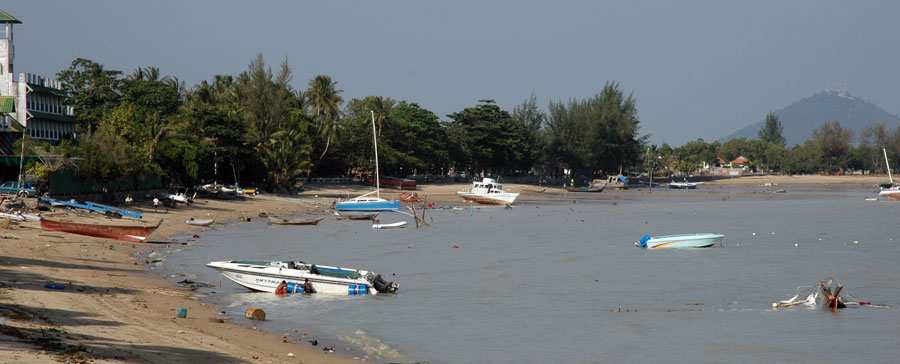
This is the beach at Achelong Bay.
There were Thai long-tail boats washed up on shore and sunken in shallow
water. Chaos reigned supreme with destruction everywhere you looked. Power boats
and yachts alike had been driven ashore.
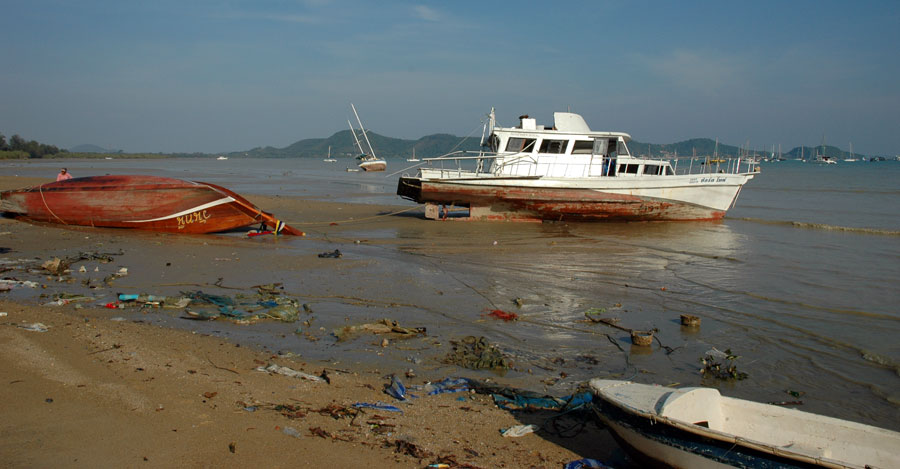
This picture shows an overturned Thai long-tail
vessel, a power yacht, and a monohull washed ashore. Trash and debris
litters the beach. These
pictures are taken two days after the tsunami when some of the
mess had already been cleaned up.
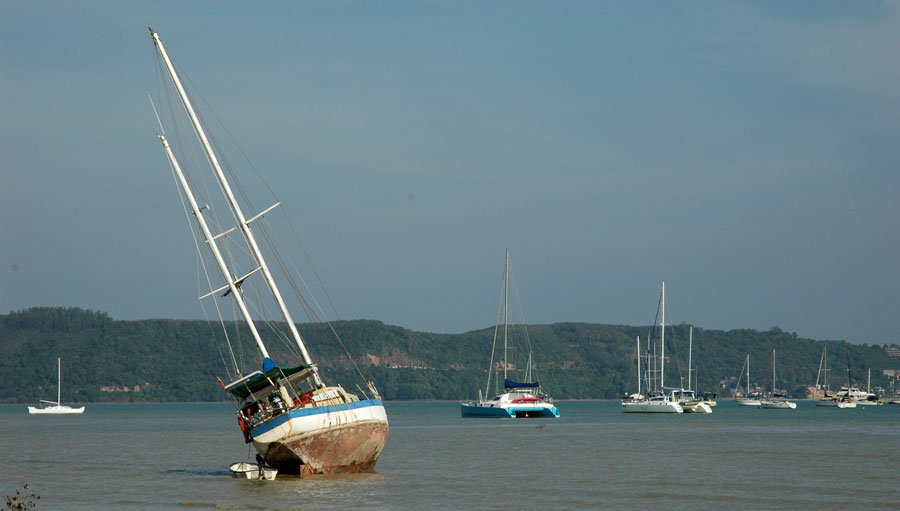
In this picture, you can see how shallow the
water is in Achelong Bay. It's that shallow water that placed
these yachts at so much risk. I talked to a
friend on a trawler motoring in this bay during the tsunami. He
was in deep enough water that he was able to motor into and over the
tsunami wave, but it was a very close call. Not all were so lucky.
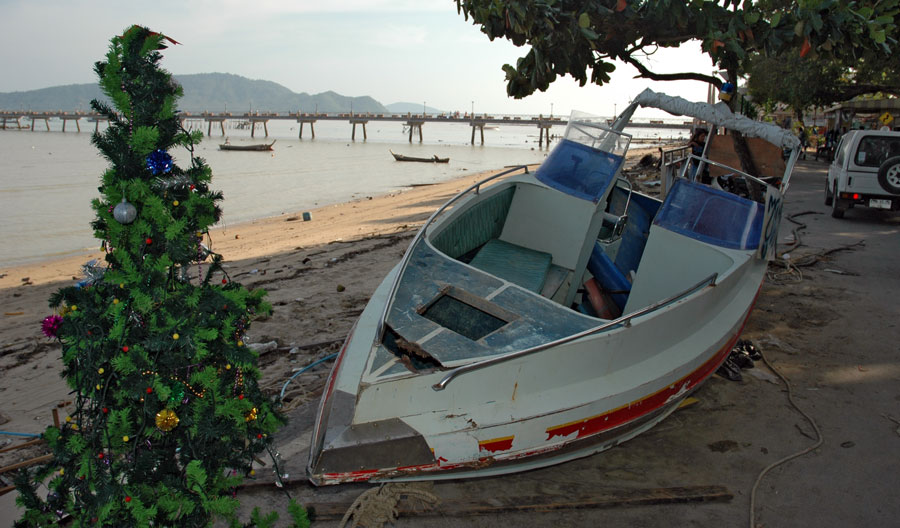
The tsunami happened the day after
Christmas, and you can see a decorated Christmas tree standing next to a
motorboat that washed ashore.
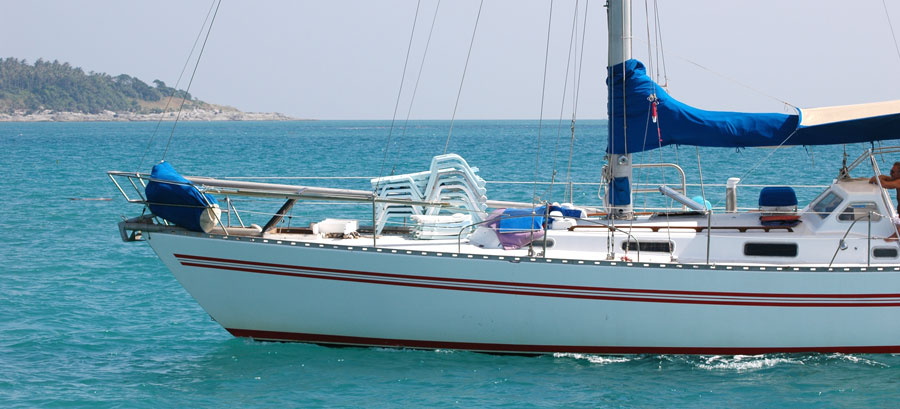
Once we discovered there had been a tsunami,
we felt it was unsafe to enter the shallows of Achelong
Bay, and we turned around to return to Niharn Bay. As we got
closer to Niharn Bay, there was already a debris line floating about
half a mile offshore. Many of the yachts in Niharn Bay made a
hasty exit from the bay after the tsunami because they were afraid that
another one might be coming. Of the hundred or so
yachts anchored in Niharn, about ten of them were already milling around
outside the harbor entrance trying to figure out what to do.
Should they return to anchor or motor around in circles outside the mouth of the bay
in deep water. Most of them motored for a couple of hours, picking
up tsunami debris and putting it on deck so that it could be returned to
hotels and resorts on shore. This yacht carried
deck chairs and cushions that they plucked out of the water.
The debris field was extensive and extended
for miles. It was a hazard to navigation, and you did not want
to suck up the floating debris into your engine's cooling
system. Like other yachts, we motored around looking for survivors
trying to avoid the debris as much as possible.
We motored for a couple of hours in
the debris field, and when it appeared that there was little additional
tsunami risk, we headed back in to Niharn Bay.
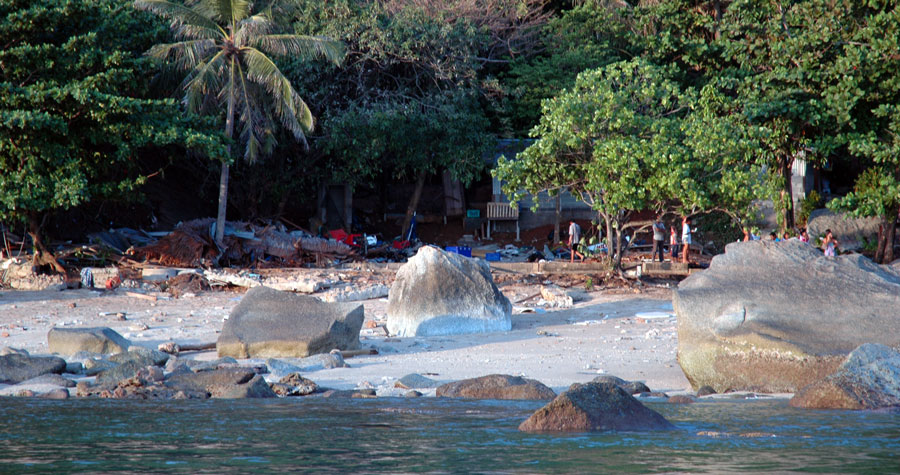
As we entered the bay, we saw that the
restaurant was destroyed where we had our Christmas party a day and a
half before. The only thing left was the concrete slab seen in the
picture above. Our dingy had been pulled up on the beach just
inside the rocks during that party. Three hundred yachties attended
the event. If the tsunami had happened during the party, it would
have wiped out three hundred members of the cruising fleet. We
were all very lucky.
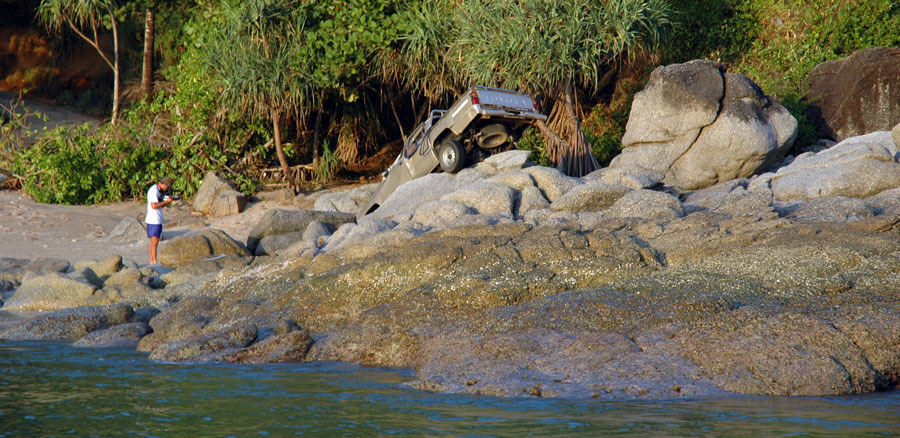
This is a pick-up truck that was parked at
our Christmas party restaurant, and it was thrown up on the rocks.
Many cars suffered a similar fate.
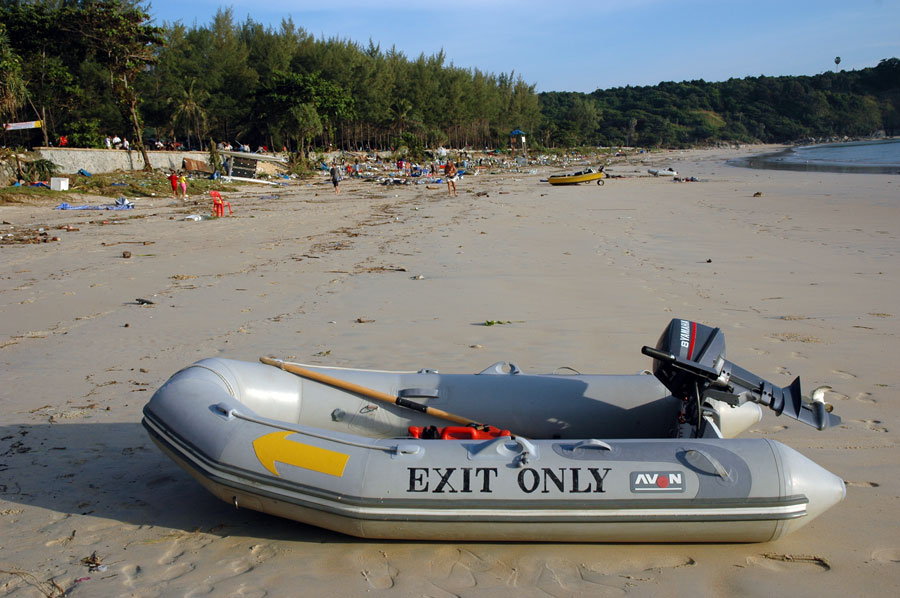
We landed our dinghy on the clearest section
of the beach to avoid sharp debris that could puncture the dinghy.
All around us there was destruction from the force of the tsunami wave.
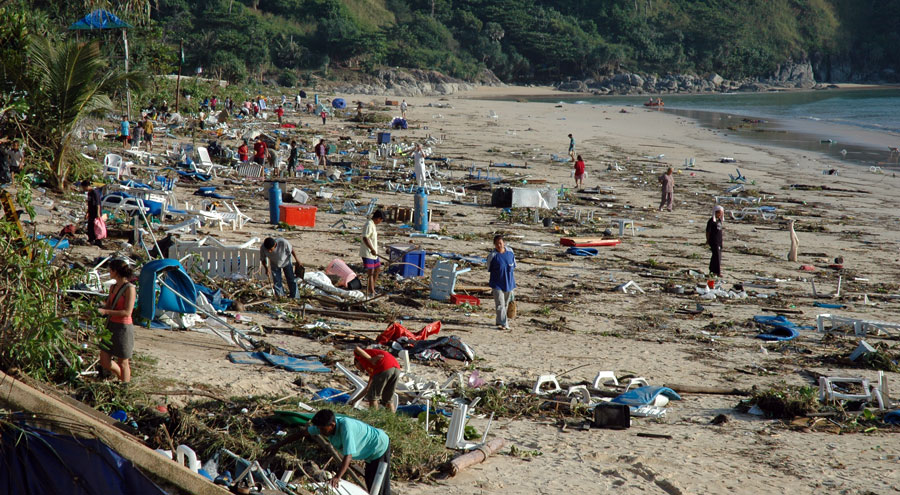
The main section of the beach was like a
city dump. The junk on the beach was the same stuff that we found
floating in the debris washed out to sea. Most of the items on the
beach were destroyed and unusable.
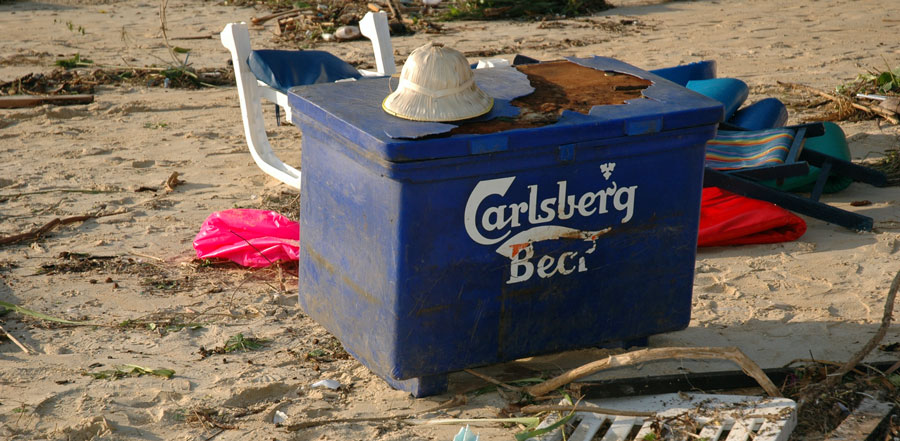
Lot's of beer coolers were strewn around the
beach. I did not check inside the coolers for a drink.
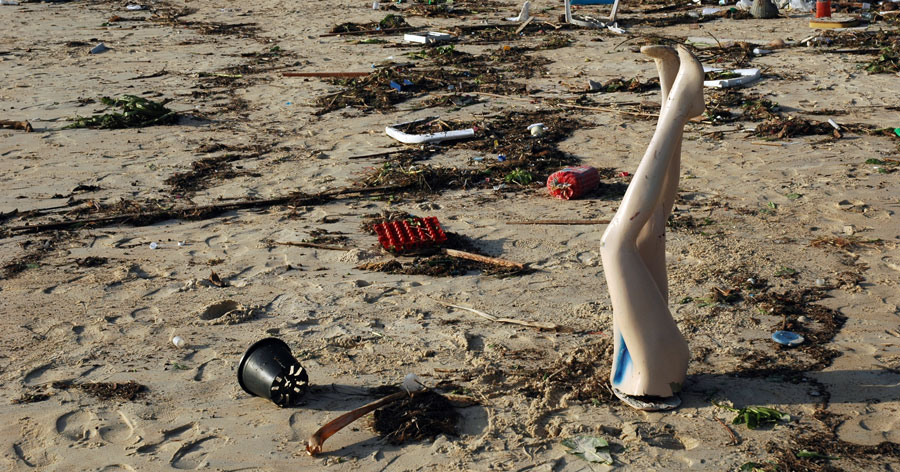
Much of the beach debris was odd, if not
weird. These mannequin legs came from a shop destroyed by the
tsunami.
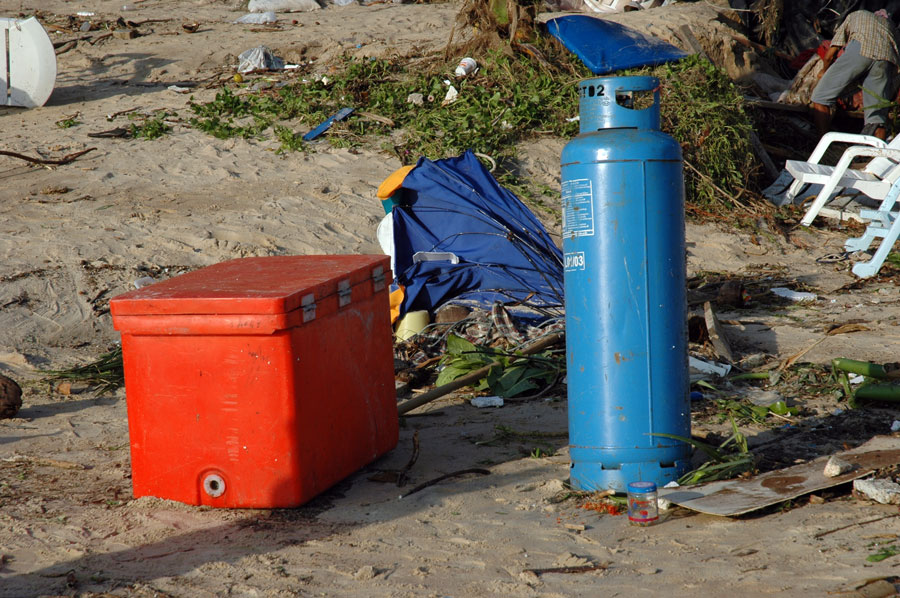
Propane tanks were strewn around the beach,
and many of them washed out
to sea where they posed a hazard to yachts leaving to cross the Indian Ocean.
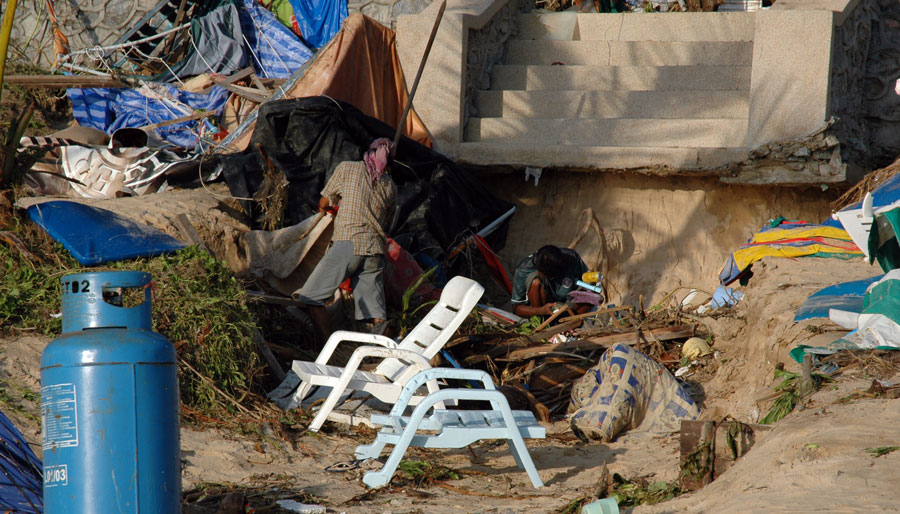
Erosion was particularly severe beneath
concrete steps leading down to the beach. Retaining walls funneled
water to the steps, creating a deluge that eroded the sand away from the
steps.
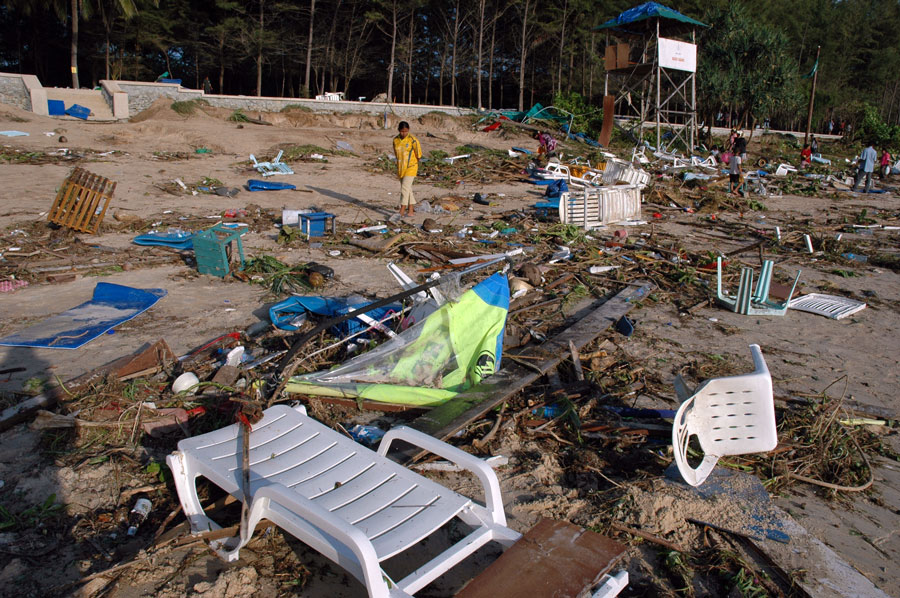
The lifeguard tower survived the tsunami's
destruction. It must have been in exciting ride inside the tower.
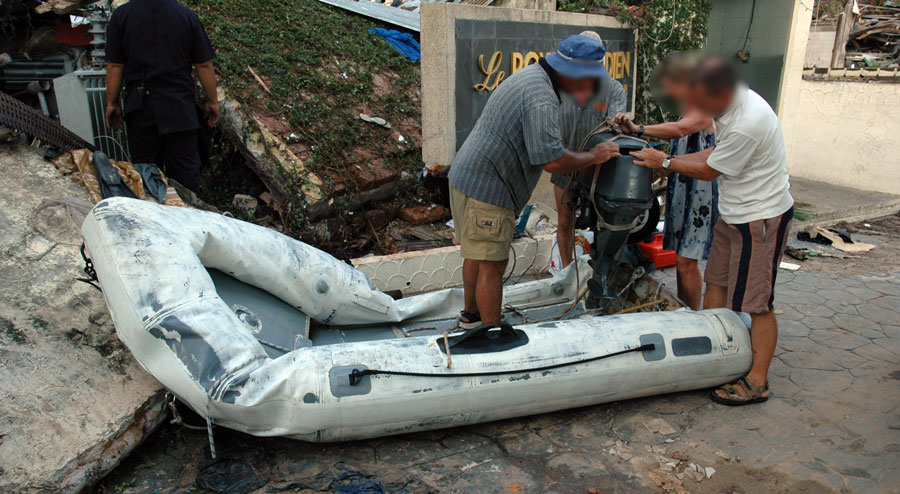
The tsunami picked up and deposited this
dinghy on the top of a building. Unfortunately, the outboard was
submerged in the process.
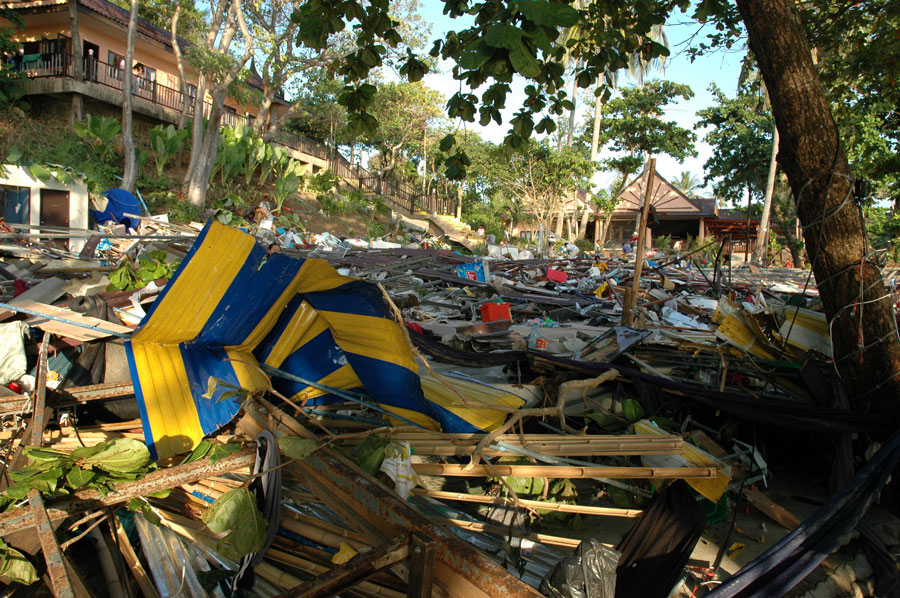
These are the shops on the northern half of
the beach. They did not fare well. Anyone inside had a high
risk of being killed by the crush of debris.
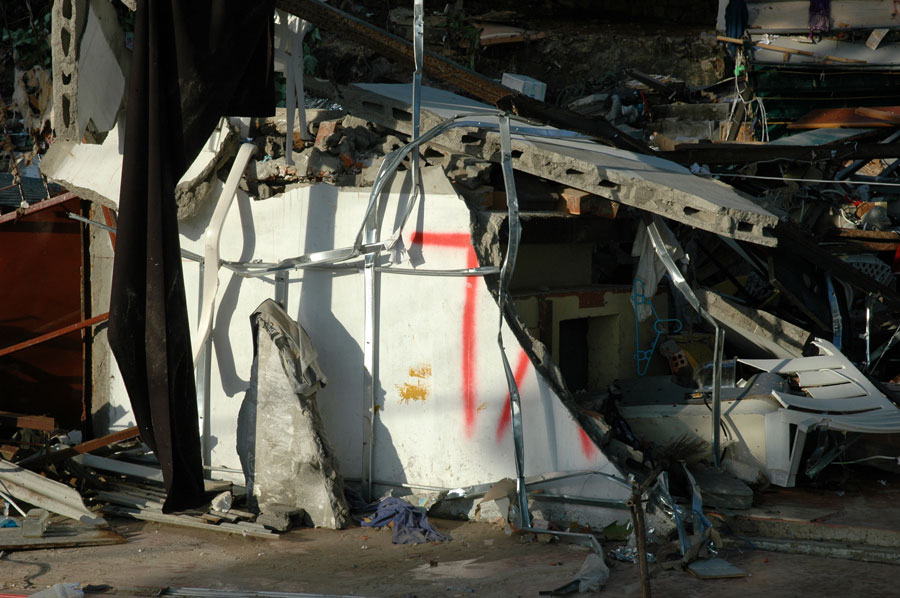
The tsunami struck with enough force to
destroy concrete block buildings.
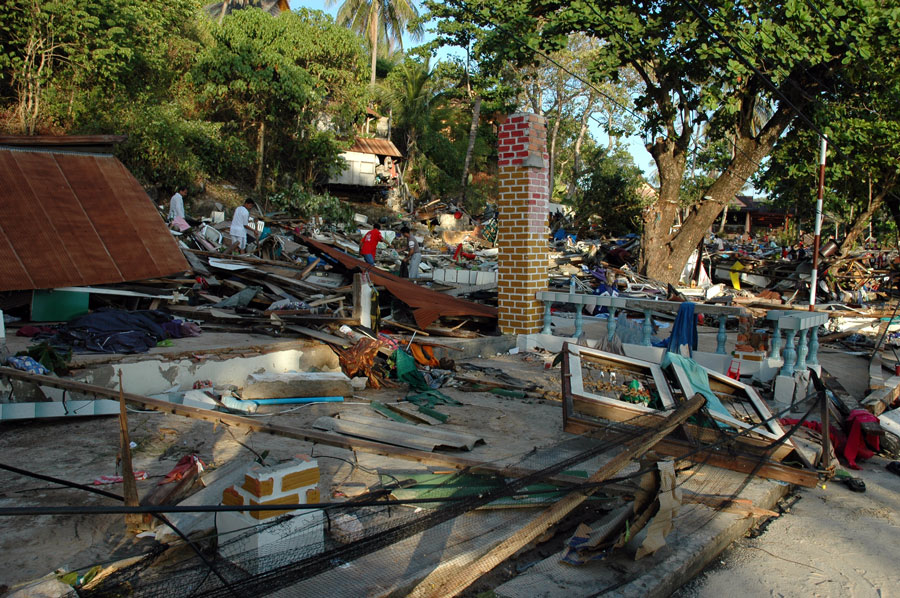
Whole building were washed away leaving only
concrete foundations.
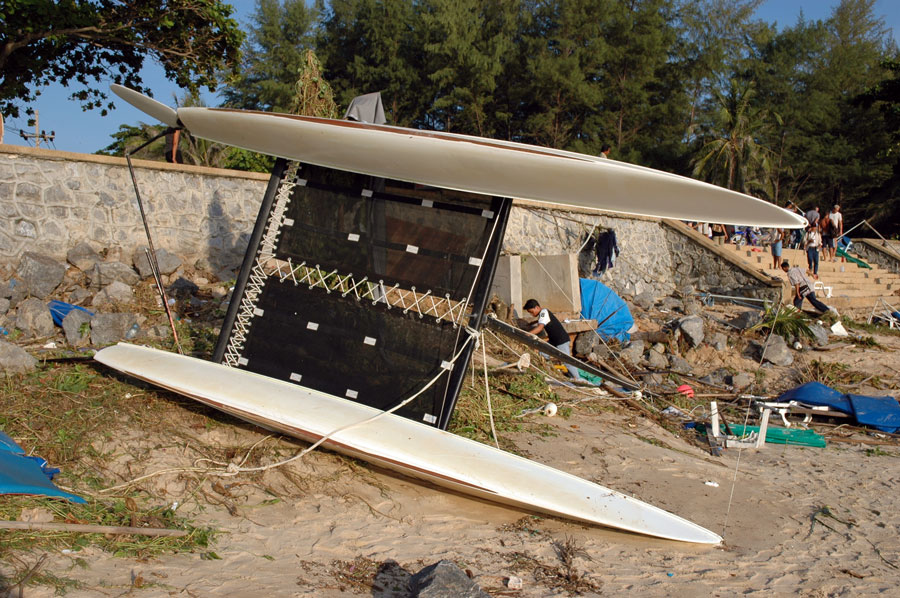
This catamaran survived intact. Yea!!!
It tipped over. Booo!

The tsunami had one other treat in store for
those of us waiting to sail across the Indian Ocean. It deposited
giant trees that were more than one hundred feet long into the ocean.
We had to carefully pick our way through all the tsunami debris as we
sailed from Thailand to the Maldives. The long arms of the tsunami
extended all the way across the Indian Ocean.
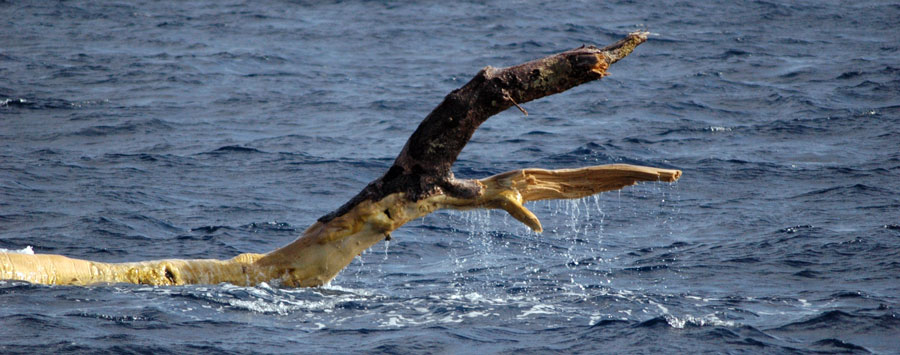
These jaws of doom could easily have
dismasted our yacht if the limbs and gotten entangled in our rigging.
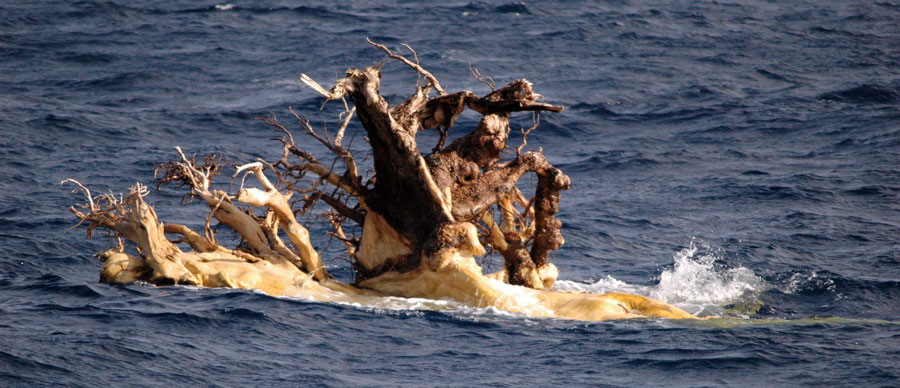
The root system anchoring this tree was at
least ten feet in diameter and was a major hazard to navigation.
Hit this at night, and it could well be the end of your Indian Ocean
Adventure.
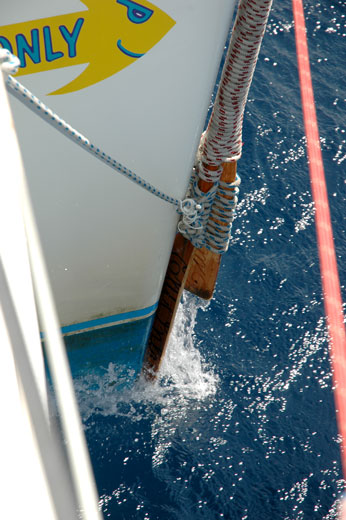
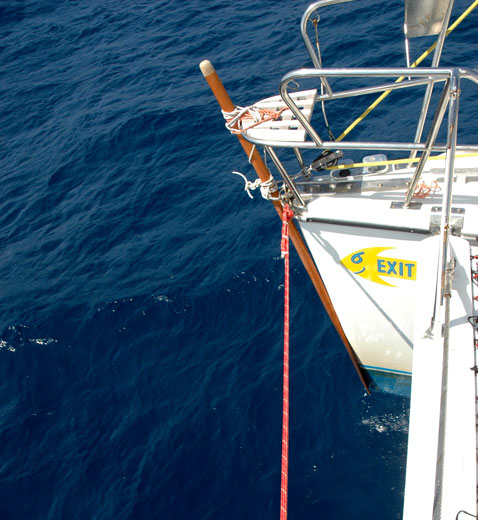
There was so much tsunami debris in the
Indian Ocean that we lashed oars down the front of our bows to act as
shock absorbers in the event that we struck large objects floating
in the water. The oar on the port bow did not survive the tsunami
debris in one piece. The picture shows the fractured blade of the
oar lashed back in position after repairs to the oar were complete.
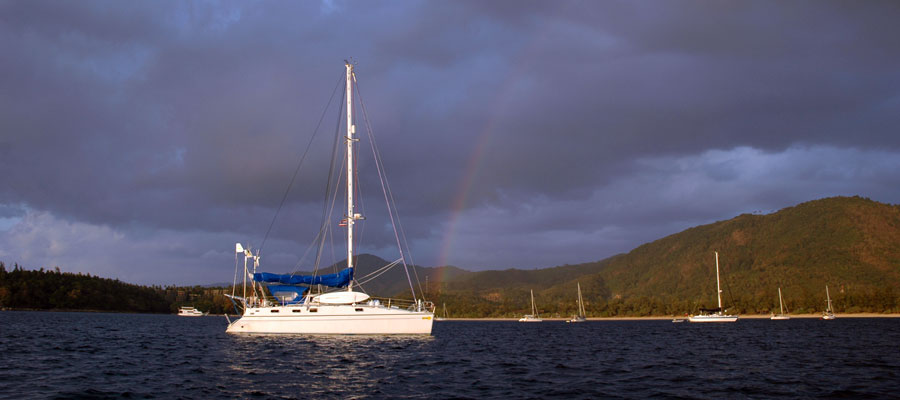
In spite of the Global Tsunami, Exit Only
had a great Thailand adventure. We came through almost without a
scratch. Before we left Thailand, we found Exit Only at the end of
a rainbow.
LESSONS LEARNED FROM THE GLOBAL TSUNAMI
1. When you are anchoring in Tsunami Land, anchor in deeper water.
Avoid the temptation to anchor close to shore. Even if you have a
shallow draft yacht, it's safer in deeper water. You will
exponentially increase your chances of survival if a tsunami should
happen.
2. If you are anchored in a bay during
an earthquake, immediately raise your anchor and head out to sea.
3. If a tsunami warning sounds, raise
your anchor and head out into deep water.
4. If you are on shore or on a dock,
and the water level starts to rapidly fall in the harbor drawing away
from the beach, immediately run for higher ground. A tsunami wave
will soon be heading your way, and if you can get to higher ground, you
may survive.
5. If a massive earthquake happens
even a thousand miles away, take tsunami warnings seriously. More
than 100,000 people died from the tsunami in Sri Lanka. The
massive loss of life was preventable to a great extent. There was
plenty of time for them to evacuate the waterfront if they had a tsunami
warning system in place.
6. When motoring through tsunami
debris, watch the temperature gage on your engine, and make sure cooling
water is flowing out of your exhaust. Tsunami debris can easily
clog and block the flow of cooling water through your engine.
7. When sailing through massive
tsunami debris, (giant logs south of Sri Lanka) stop your boat and heave
to at night. You cannot afford to collide with a giant log in the
dark. One steel yacht sailed on through the night off Sri Lanka
and struck a log in the dark. He sailed over the log without
sustaining hull damage, but his wind vane self-steering was severely
damaged when it struck the log. Sailing over logs in the dark is
dangerous. It's a good way to hole a yacht, bend and break
rudders, and destroy wind vane self-steering.
8. When sailing through tsunami
debris, it's a good idea to have a person on the bow scanning the water
for partially submerged tsunami debris.
9. Anything that you can do to protect
your bow from tsunami debris is a good idea. We lashed oars on the
bows of Exit Only to distribute the forces in the event of an impact
with tsunami debris.
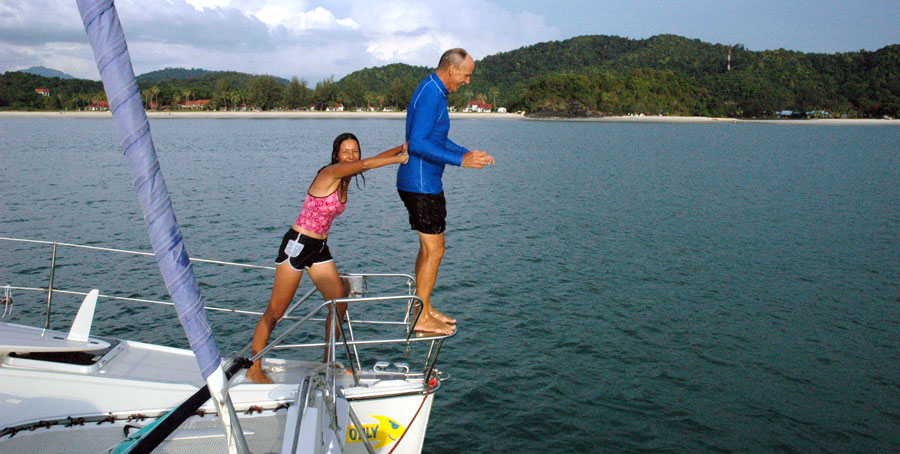
DON'T HESITATE! TAKE THE
PLUNGE NOW AND ORDER
THE RED SEA
CHRONICLES. JUMP INTO A
GREAT CRUISING CATAMARAN DVD. YOU WILL BE GLAD THAT YOU DID!